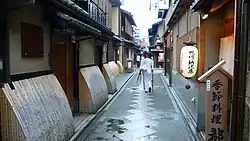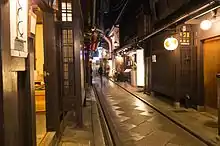Ponto-chō
Ponto-chō (先斗町) is a hanamachi district in Kyoto, Japan, known for its geisha and maiko, and is home to many of the city's okiya and traditional tea houses. Like Gion, Ponto-chō is famous for the preservation of forms of traditional architecture and entertainment.


.jpeg.webp)
Etymology
The name "Ponto" is believed to come from the Portuguese word "ponte" (bridge), and is written in kanji used for their sound only (ateji).[1] The Japanese word "-chō" means town, block or street.
District
Ponto-chō as a district is for the most part constructed around a long, narrow alleyway, running from Shijō-dōri to Sanjō-dōri, one block west of the Kamo River. This location is also known as the traditional location for the beginning of kabuki as an art form, and a statue of kabuki's founder, Izumo no Okuni, stands on the opposite side of the river. The district's crest is a stylized water plover, or chidori.
Cultural features
Geisha (known locally as geiko) and maiko have existed in Ponto-chō since at least the 16th century, as have prostitution and other forms of entertainment. Today, the area, lit by traditional lanterns at night, contains a mix of exclusive restaurants — often featuring outdoor riverside dining on wooden patios — geisha houses and tea houses, brothels, bars, and cheap eateries.
The area is also home to the Ponto-chō Kaburenjō Theatre at the Sanjō-dōri end of the street. This theatre functions as a practice hall for geisha and maiko, and has functioned as the location for the annual Kamogawa Odori — a combination performance of traditional dance, kabuki-like theatre, singing and the playing of traditional instruments — since the 1870s.
In the 1970s, American anthropologist Liza Dalby visited Kyoto for a year as part of her doctoral studies into the institution of geisha in modern Japanese society, eventually unofficially becoming a geisha as part of her research. Dalby later wrote a well-received book, Geisha, about the experience.[2]
See also
References
- Dalby, L., 2000. Geisha, 3rd ed. Vintage Random House: London.
- Dalby, Liza (1983). Geikoa. Berkeley: University Of California Press. ISBN 0-9658812-6-1.
External links
- Ponto-cho Noren-kai(in Japanese)
- Kamogawa Odori (Pontochō Kaburenjō Theater)
- 35°00′29″N 135°46′16″E (Pontochō Kaburenjō Theater)